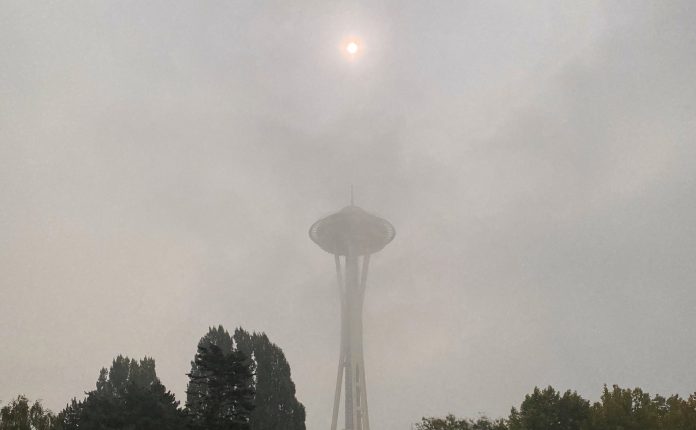
I woke up coughing this weekend–no, not from Covid-19–from wildfire smoke that’s settled on Seattle like a clammy yellow shroud.
Last Friday was a better day because all five members of the Seattle City Council Governance and Education Committee–Councilmembers González, Mosqueda, Juarez, Lewis, and Sawant–unanimously passed Councilmember Pedersen’s Resolution 31933, the Carbon Note, and sent it on to a full Council vote on September 21st. Councilmembers González and Mosqueda were instrumental in working to edit the resolution to be more actionable by Council Central staff, and aligned the resolution with the City’s Race and Social Justice Initiative. The Mayor’s Office also testified in favor.
What’s in a Carbon Note?
The theory behind a Carbon Note is that all projects we collectively create should be guided by how much extra carbon those projects put into the atmosphere, or draw down from it. Just as Councilmembers are given information about construction and operating costs of the projects they vote on in a Fiscal Note, our elected officials should be able to know if they are voting on projects that increase or decrease carbon dioxide (CO2) and equivalent gases or if they will have no impact on our atmospheric load. A Carbon Note is good in theory. We value what we measure and a Carbon Note tells us to measure collective CO2.
How do we measure carbon?
Measuring carbon can be difficult in practice. It’s hard to calculate embodied carbon and externalities building a single bike lane, a multifamily mixed use housing project, or a major bridge, but local organizations including the University of Washington’s Climate Impacts Group and the Northwest chapter of the National Climate Assessment are dedicated to creating models to calculate collective CO2.
How are we doing with carbon in Seattle?
Not well, even though we’re decreasing our per capita emissions, we’re not on track to become carbon neutral by 2050. Even as we get better at calculating CO2 in individual projects, we need to make sure we’re not so distracted measuring the trees that we overlook the forest. The most CO2-positive actions we can take are to support very dense, transit-rich, walkable 15-minute neighborhoods, all electrified, with good tree canopy, as we welcome thousands of new residents every year into a variety of housing types for people of all incomes and ethnicities. It’s possible to calculate the carbon impact of density, but easier to focus on single projects rather than the whole suite of actions we must support to build a dense, resilient city.
Who supports Carbon Notes?
At the September 11th City Council committee meeting to vote on the Carbon Note, Climate Solutions wrote in support of Resolution 31933, and people who gave public testimony in favor included scientists Dr. Heather Price and Mike Ruby, as well as University of Washington sophomore Meghna Shankar representing Fridays For Future Seattle, Katie Wilson from the Transit Riders Union, former Seattle Councilmember Jim Street, and me, a PhD in Urban Design and Planning. (Full disclosure: I ran for Seattle City Council last year on a climate action platform when I proposed the idea of a Carbon Note. I’ve been working in the climate arena for decades and am the founder of Seattle Neighborhood Greenways and 350 Washington State.)
I want to thank Councilmember Pedersen for bringing forward the idea of a Climate Note, the staff of Council President González for making important technical legislative changes to the Resolution 31933 before bringing it to her Committee, and Councilmember Mosqueda for amending the Resolution so it had a stronger social justice component.
What will the Carbon Note Resolution do?
Here’s the exactly what Resolution 31933 will ask of projects before they are voted on:
1. Emissions: Please provide a qualitative response. Consider net impacts. For example, if the legislation could decrease direct emissions, consider whether it might increase emissions indirectly or elsewhere. New modeling is not required for this response. See sources of emissions in Seattle by sector (transportation, buildings, waste, and industrial) in the Seattle Community Greenhouse Gas Emissions Inventory. Document this source and any other methodologies and sources used for this response.
2. Resiliency: Will the action(s) proposed by this legislation increase or decrease Seattle’s resiliency (or ability to adapt) to climate change in a material way? If so, explain. If it is likely to decrease resiliency in a material way, describe what will or could be done to mitigate the effects. See potential sector-specific actions (Transportation, Land Use & the Built Environment, City Buildings, Parks, Drainage & Water Supply Systems, Electricity System and Community Preparedness) in Preparing for Climate Change, published by the Office of Sustainability and Environment, and findings by the University of Washington’s Climate Impacts Group and National Climate Assessment’s northwest chapter. Please document these or any other methodologies and sources used for this response. Describe the potential climate resiliency impacts of not implementing the proposed legislation. Discuss any potential intersections of climate resiliency and race and social justice impacts, if not previously described in Section 4e.
What’s next for Carbon Notes?
As with any non-binding resolution, it’s vital that climate advocates such as the Green New Deal Oversight Board keep watch as Council staff begins to evaluate the carbon impacts of City projects starting in January 2021. Carbon Notes are just one small step. There are many more steps to come to build the dense, equitable, thriving, resilient Seattle we all long for.
You can view the full legislation and any changes as it moves forward on this webpage. The vote is expected September 21st.
The featured Space Needle photo is by Mark Ostrom and is used with permission.
